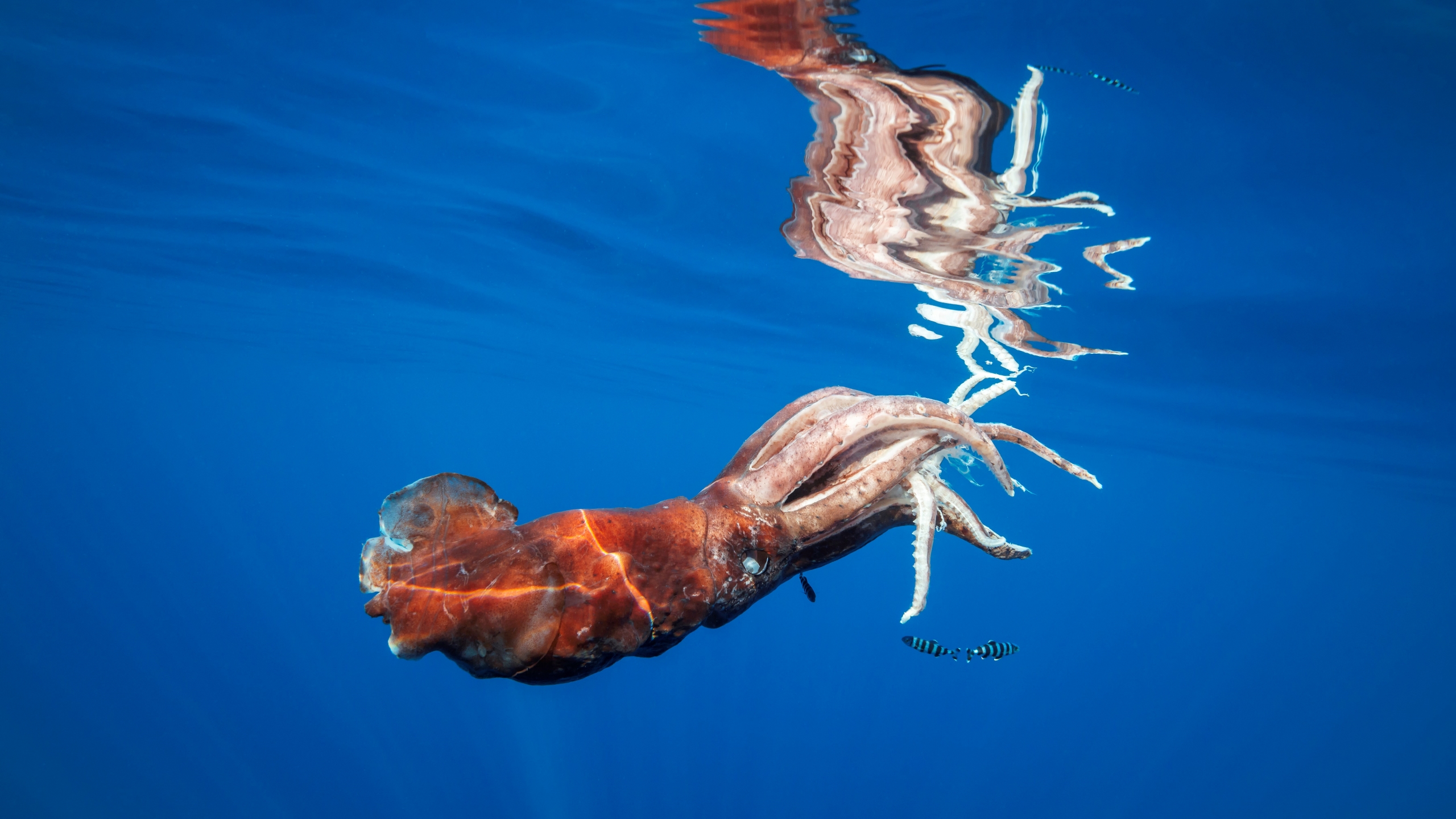Giant squid: The real-life ocean Kraken
Giant squid may not attack ships but they are still fearsome predators.

Giant squid (Architeuthis dux) are mysterious deep-sea predators with basketball-size eyes and tentacles that can stretch to 33 feet (10 meters) long. Giant squid are one of the world’s largest invertebrates and belong to an ancient group of mollusks called cephalopods, which also includes octopuses, cuttlefish and nautiluses.
Giant squid sightings are likely what inspired tales of the ship-destroying Kraken from Scandinavian mythology. Real giant squid live at depths of at least 2,950 feet (900 m) below the ocean's surface and aren't known to attack ships.
Scientists still have much to learn about the lives of giant squid. Only twice have researchers been able to catch footage of these elusive giants in their natural environment — both times within the last 10 years, Live Science previously reported. Experts still aren't sure how many giant squid there are, or how many different species may exist, according to the American Museum of Natural History (AMNH) in New York.
Related: 500 million-year-old fossil is the granddaddy of all cephalopods
How big is a giant squid?
The biggest giant squid ever found was almost 43 feet (13 m) long, including its tentacles — that's about as long as a semi-trailer. However, scientists estimate that the species may be able to grow up to 66 feet (20 m) long, based on the size of giant squid beaks found in the stomachs of sperm whales (Physeter macrocephalus), which prey on giant squid, — according to the Smithsonian National Museum of Natural History. In many squid species, females are larger than males, and scientists believe the same is true for giant squid.
Size: Up to 66 feet (20 m) long
Life span: Less than 5 years
Conservation status: Least concern
Squid have eight arms and two tentacles, with spiked suckers that help grasp and pull prey toward their beaks. Squid beaks are made out of hard chitin, the same material as insect exoskeletons, with sharp edges that are perfect for chopping up prey into bite-size chunks, according to the AMNH.
Related: Stunningly intact giant squid washes ashore in South Africa
Get the world’s most fascinating discoveries delivered straight to your inbox.
Giant squid vs colossal squid
Giant squid are massive, but they still have competition for the title of biggest ocean cephalopod. Colossal squid (Mesonychoteuthis hamiltoni) live in the Southern Ocean at depths of at least 3,280 feet (1000 m) and have larger and heavier bodies than giant squid, according to the Museum of New Zealand Te Papa Tongarewa. One of the few known colossal squid specimens, held at the Te Papa museum, weighs 992 pounds (450 kilograms), while giant squid are thought to only weigh up to about 606 pounds (275 kg). Colossal squid can reach lengths of 45 feet (14 m), but giant squid can grow even longer because of their two elongated tentacles, and may reach 66 feet, according to the Smithsonian.
Where do giant squid live?
Giant squid can be found in oceans around the world at depths of at least 2,950 feet, but their exact geographic range is unknown. Giant squid are most often recorded in the North Atlantic and North Pacific, and near South Africa and New Zealand, according to the International Union for Conservation of Nature (IUCN).
Some scientists believe that giant squid should be split into multiple different species, including separate species for populations in the North Atlantic, North Pacific and Southern Ocean. However, a 2013 study published in the Proceedings of the Royal Society B analyzed 43 giant squid samples collected from across their range and found little genetic diversity. This suggests giant squid are a single species and intermingle through migration.
Related: Giant squid all one big, happy family
Breeding
Giant squid are solitary, and scientists aren't sure how males find females to breed. Researchers hypothesized that because males and females probably only encounter each other occasionally, the females would collect and store sperm from multiple males. However, a female caught off the coast of Japan in 2020 only had sperm from a single male, suggesting giant squid may actually be monogamous, Live Science previously reported.
Kingdom: Animalia
Phylum: Mollusca
Class: Cephalopoda
Order: Teuthida
Family: Architeuthidae
Genus & species: Architeuthis dux
Source: ITIS
Scientists aren't sure what squid mating even looks like. Experts assume that males place their sperm onto the female squid's arms, and suspect females may release eggs and hold them as they are fertilized in the water. The female then releases millions of fertilized eggs stuck together as an egg mass, according to the Smithsonian.
Baby squid are just 1 to 4 millimeters long when they hatch from their mother's eggs, and feed in the upper ocean at depths of about 650 feet (200 m), before descending deeper into the ocean when they mature, according to the Delaware Museum Of Natural History. Squid have short lifespans, and most species only live for one to three years. While scientists don't know exactly how long giant squid live, they believe it is no more than five years so they must grow very quickly, according to the Smithsonian.
What do giant squid eat?
Giant squid eat other, smaller squid species and hunt fish, including blue grenadier (Macruronus novaezelandiae), a torpedo-shaped deep-sea fish, according to the University of Michigan's Animal Diversity Web.
Giant squid are themselves prey for sperm whales. But the cephalopods don't go down without a fight, and sperm whales are often found with sucker-shaped scars after hunting giant squid, according to the American Museum of Natural History.
Related: Beached sperm whale in Australia shows scars from tussle with a giant squid
The Kraken from Scandinavian mythology, likely inspired by giant squid sightings, was said to appear as small islands on the water to fool sailors into thinking it was land. As the story goes, the giant sea creature would then use its tentacles to pull ships and their crews beneath the waves. But humans are not part of the real giant squid's diet, and there's no reason for giant squid to attack ships.
Are giant squid endangered?
Giant squids are categorized as a species of least concern by the IUCN, which means they are not threatened with extinction. They have a wide geographic range and are less likely to be negatively impacted by human activity than many other species, as they live in the deep ocean. However, scientists don't know for sure how big the giant squid population is or what threats it could be facing.
Additional resources
- Book about squid and other cephalopods: "Monarchs of the Sea: The Extraordinary 500-Million-Year History of Cephalopods" (The Experiment, 2020).
- The American Museum of Natural History has a short video on YouTube describing encounters between giant squid and sperm whales.
- BBC Earth offers more information about giant squid and their links to the mythological Kraken.

Patrick Pester is the trending news writer at Live Science. His work has appeared on other science websites, such as BBC Science Focus and Scientific American. Patrick retrained as a journalist after spending his early career working in zoos and wildlife conservation. He was awarded the Master's Excellence Scholarship to study at Cardiff University where he completed a master's degree in international journalism. He also has a second master's degree in biodiversity, evolution and conservation in action from Middlesex University London. When he isn't writing news, Patrick investigates the sale of human remains.





